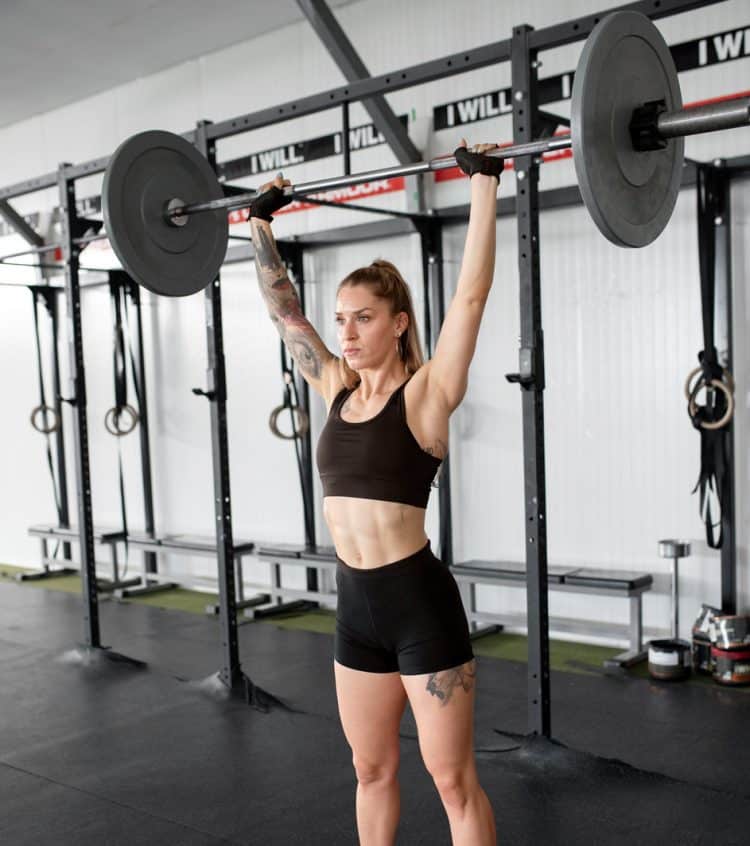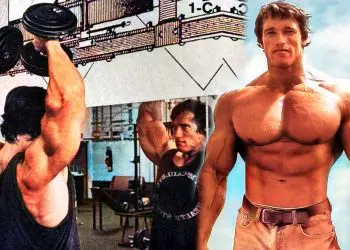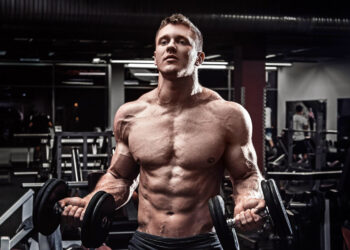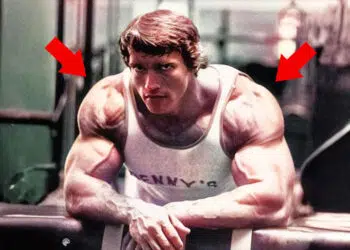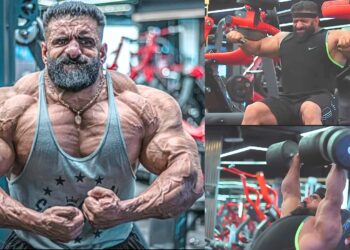It’s often said that shoulders maketh the man, which is a misquote from William Shakespeare. While a lot of guys DO want muscular, sculpted shoulders, they look good on women, too.
A well-developed pair of shoulders will give your body a pleasing V-taper and make your waist look smaller. They also stand out when you’re wearing a short-sleeved top or dress.
However, there is a fine line between shapely, feminine shoulders and deltoids that make you look like a linebacker!
In this article, we reveal what muscles make up the shoulders and how best to train them.
Shoulder Anatomy
If you want to build the best possible shoulders, you need to know how these muscles function. That way, you can pick the right exercises for your workouts. So, buckle up and grab your pen – we’re about to school you with shoulder anatomy 101!
The shoulders, or deltoids to give them their proper name, are made up of three sets of fibers called heads:
Level Up Your Fitness: Join our 💪 strong community in Fitness Volt Newsletter. Get daily inspiration, expert-backed workouts, nutrition tips, the latest in strength sports, and the support you need to reach your goals. Subscribe for free!
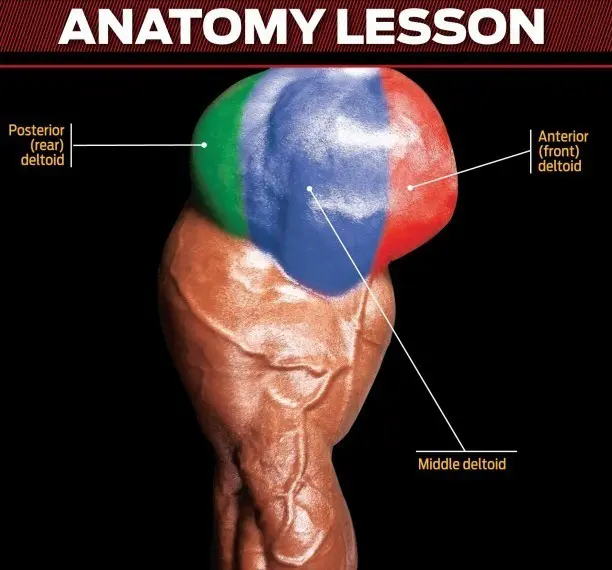
Anterior deltoid
This deltoid head is located on the front of your shoulder. Its functions are flexion, horizontal flexion, and medial rotation of the upper arm. The anterior deltoid is involved in all pushing exercises and, as such, is often overdeveloped.
Because of this, the front deltoid doesn’t usually need more than an exercise or two per workout. Too much anterior deltoid training will make your shoulders look bulky and rounded rather than shapely and sexy.
Medial deltoid
Located on the side of your shoulder, the medial deltoid gives your upper body its width. Think of this muscle like a shoulder pad. The function of the medial deltoid is the abduction of the shoulder joint, meaning to lift your upper arm out and away from your body.
All lateral raise-type exercises work the medial deltoid.
Posterior deltoid
The posterior or rear deltoid head is an important postural muscle. Its functions are the opposite of the anterior deltoid, and it’s responsible for extension, horizontal extension, and external rotation of the shoulder joint.
This deltoid head is often underdeveloped because it’s out of sight and out of mind. However, training the posterior deltoid can do wonders for your posture and make you look more confident and self-assured.
Rotator cuff
Hidden below your deltoids is another group of shoulder muscles – the rotator cuff. While these muscles don’t contribute much to the size of your shoulders, they are critical for shoulder joint function and health.
The rotator cuff muscles are:
- Supraspinatus
- Infraspinatus
- Teres minor
- Subscapularis
Training the rotator cuff can help keep your shoulders healthy and ward off shoulder pain and injuries, which are often debilitating.
Why Women Should Train Their Shoulders
Some women are worried that training their shoulders will make them look masculine. However, this worry is largely unfounded. While women CAN build big shoulders, it won’t happen by accident, and you won’t wake up tomorrow with shoulders so big they cast giant shadows!
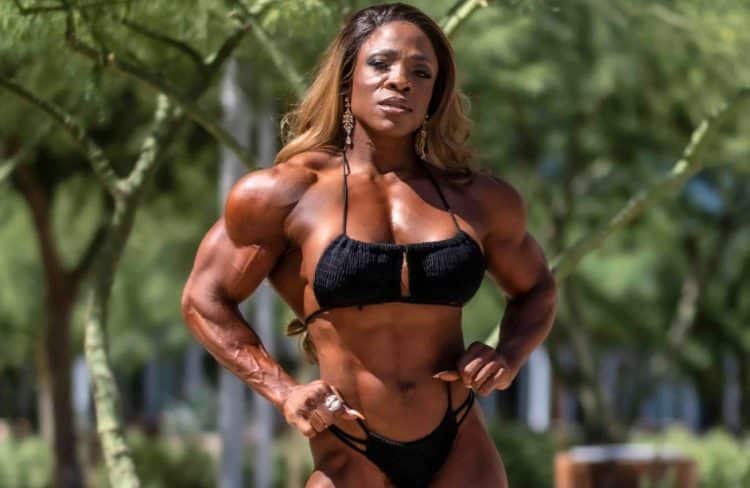
Female bodybuilders train long and hard to build their massive muscles, and general shoulder training won’t build cannonball delts.
Instead, shoulder training for women will have the following benefits:
1. A pleasing upper body shape
A well-shaped pair of shoulders will give your upper body an appealing, athletic profile. Your shoulders are on show more often than you realize, and training them will make the most of this prominent body part.
2. Better posture
Posture is the alignment of your joints, and posture can be good or bad. Good posture means your joints are correctly aligned, so there is very little stress on the surrounding muscles. This not only looks better but means less pain and tension. Good shoulder posture means no slouching, and you’ll naturally look taller, slimmer, younger, and more confident.
In contrast, underdeveloped shoulders and poor posture can add years and pounds to your appearance and stop your shoulders from functioning as they should. This can also contribute to neck and shoulder pain.
3. Improved athletic performance
There are very few athletic endeavors that do not involve the shoulders. The same is true for the exercises you do in the gym. Whether you are a competitive athlete or a recreational exerciser, strengthening your shoulders and ensuring all three deltoids and the rotator cuff is strong and healthy will boost your performance.
4. Fewer shoulder injuries
The shoulder is the most mobile joint in the human body and also the most unstable. Joint instability means shoulder injuries are all too common. While some shoulder injuries are mild and merely annoying, others can stop you from exercising for good.
Training your shoulders will make the joints more stable, less prone to wear and tear, and more injury resistant. While you can’t “bulletproof” your shoulders, you can make them more resilient, and strong shoulders are healthy shoulders!
5. Personal satisfaction
Many women avoid training their shoulders, but if you are reading this, you probably aren’t one of them! Shoulder workouts can be very satisfying, and you’ll love how they change your appearance.
Burning deltoids and a good pump are a great reward for your hard work, and you’ll soon start to see your muscles change as you continue your workouts. This is impowering and motivating.
The Best Shoulder Workout for Women – Gym Edition
So, you want to build head-turning shoulders – good for you! But before you begin, you must spend a few minutes warming up and preparing your muscles and joints for what you’re about to do.
Begin with 5 to 10 minutes of easy cardio followed by dynamic mobility and flexibility for your shoulder muscles and joints. Take note of any soreness or stiffness, and keep working until you feel loose and limber. Read more about how to warm up for strength training here.
Ready? Then let’s get to work!
Do this workout 1-2 times per week on non-consecutive days, e.g., Monday and Thursday. Also, avoid training your chest too close to your shoulder workout, as many of the exercises and muscles are similar.
| # | Exercise | Sets | Reps | Recovery |
| 1 | Face pulls | 4 | 12-15 | 60 seconds |
| 2 | Seated side lateral raise | 3 | 12-15 | 60 seconds |
| 3 | Arnold press | 2 | 8-10 | 90 seconds |
| 4 | Cuban press | 2 | 8-10 | 90 seconds |
| 5 | Cable external rotation | 2 | 15-20 | 60 seconds |
Get the most from this workout by performing all the exercises with perfect technique.
1. Face pulls
Target muscles: Posterior deltoids, middle trapezius, rhomboids.
Your gym shoulder workout begins with the most critical deltoid head – the posterior. Hitting this head first means you can put lots of energy into what is usually a neglected muscle. It’s also a great way to warm up your shoulder joints.
Steps:
- Attach a rope handle to a chest-high pulley.
- Hold the handles and step back with your arms straight and hands level with your shoulders.
- Bend your knees slightly for balance. Brace your core, and pull your shoulders down and back.
- Bend your arms and pull your hands into either side of your face. Imagine you are trying to poke your thumbs into your ears.
- Extend your arms, roll your shoulders forward, pull them back again, and repeat.
Tips:
- You can also do this exercise seated instead of standing if you prefer.
- No adjustable cable machine? Do wide-grip seated rows to your chest instead.
- Pause at the mid-point of each rep for 1-3 seconds to maximize the contraction in your deltoids and upper back.
Read more: Face Pull Guide: Muscle Worked, Benefits, How-To And Variations
2. Seated side lateral raise
Target muscle: Medial deltoid
Located on the outside of each shoulder, your medial deltoids give your upper body its lateral width. However, before you start worrying that this exercise will build masculine-looking shoulders, it’s worth remembering that the medial deltoids tend to grow slowly. However, developing them will give you shapely, sculpted shoulders.
Steps:
- Set the backrest on an adjustable bench, so it’s just off vertical, i.e., 80 degrees.
- Sit on the bench and hold a dumbbell in each hand. Plant your feet flat on the floor and let your arms hang straight down, palms facing inward.
- Brace your abs, pull your shoulders down and back, and bend your elbows slightly.
- Raise your arms up and away from your sides to shoulder height.
- Lower your arms back down and repeat.
Tips:
- Lead with your pink finger to maximize medial deltoid engagement.
- Keep your shoulder down to avoid inadvertently engaging your upper traps and getting “yoked.”
- No dumbbells? Do this exercise on a regular chair with a resistance band under your legs.
3. Arnold press
Target muscles: Anterior deltoid, triceps, serratus anterior.
The Arnold press is named after bodybuilding legend Arnold Schwarzenegger. This exercise not only emphasizes the front deltoid but also uses the middle and rear heads. The Arnold press is arguably the best overhead exercise for women, providing an excellent balance between front, middle, and back deltoid development.
Steps:
- Stand with your feet roughly shoulder-width apart, holding a dumbbell in each hand.
- Raise the weights up so your arms are bent and the dumbbells are in front of your shoulders, palms facing your face.
- Pull your shoulders down and back, lift your chest, and brace your core.
- Next, spread your elbows and simultaneously press the weights up and overhead, twisting your wrists so your palms face forward as you straighten your arms. Stop just short of fully locking your elbows.
- Lower the weights back to the starting position by reversing this movement.
- Repeat for the prescribed number of reps.
Tips:
- You can do this exercise seated or standing as preferred.
- Use light to moderate weights and medium to high reps for the best results.
- Try doing alternating Arnold presses for variety.
Read more: Arnold Press — How-To, Muscles Worked, Variations, and Benefits
4. Dumbbell Cuban press
Target muscles: Anterior, medial, posterior deltoid, biceps, triceps.
Legend has it that the dumbbell Cuban press was invented to fix shoulder problems in the Cuban Olympic weightlifting team. Whether that’s true or not, this is an excellent way to hit all three deltoid heads in one training movement.
Level Up Your Fitness: Join our 💪 strong community in Fitness Volt Newsletter. Get daily inspiration, expert-backed workouts, nutrition tips, the latest in strength sports, and the support you need to reach your goals. Subscribe for free!
Steps:
- Hold a dumbbell in each hand in front of your hips. Stand with your feet about hip-width apart, knees slightly bent, core braced, and shoulders pulled down and back.
- Bend your elbows and upright row the dumbbells up to your sternum/lower chest. Your upper arms should be roughly parallel to the floor, elbows bent to 90 degrees.
- Without lowering your upper arms, externally rotate your shoulders and raise the weights up, so they’re just above your head.
- Press the dumbbells up to arm’s length.
- Bend your arms and lower the weights using the opposite motion.
Tips:
- Do this exercise seated if preferred.
- You can also do this exercise with a barbell or cable machine.
- This exercise works best with light weights and for high reps.
5. Cable external rotation
Target muscles: Rotator cuff, posterior deltoids.
Your final shoulder exercise targets your external rotators (supraspinatus, infraspinatus) and posterior deltoid. Most upper body exercises involve internal rotation, which means these muscles are often underdeveloped and weak. This exercise redresses this imbalance and improves shoulder stability and health.
Steps:
- Attach a D-shaped handle to an adjustable pulley machine set to around mid-chest height. Stand side-on to the pulley, your knees slightly bent and your core braced.
- Hold the handle with your furthest hand so your forearm rests across your abdomen and your elbow is bent to 90 degrees.
- Rotate your lower arm out and away from your body as far as your mobility allows.
- Return to the starting position and repeat.
- Rest a moment, and then do the same number of reps with the other arm.
Tips:
- No cable machine? Do this exercise with a resistance band instead.
- Try raising your arm away from your side to hit your external rotators from a different angle.
- You can also replicate this exercise with a dumbbell and bench like this:
The Best Shoulder Workout for Women – Home Edition
You don’t need to go to the gym to build shoulders you can be proud of. Here’s a workout you can do at home using nothing other than some light dumbbells, a towel, and a couple of resistance bands!
As before, make sure you spend a few minutes preparing your muscles and joints for what you are about to do. A great workout starts with a good warm-up.
| # | Exercise | Sets | Reps | Recovery |
| 1 | Resistance band pull-aparts | 4 | 12-15 | 60 seconds |
| 2 | Isometric towel lateral raise | 3 | 15-20 seconds | 60 seconds |
| 3 | Alternating top-down dumbbell press | 2 | 8-10 | 90 seconds |
| 4 | Alternating front/lateral raise | 2 | 8-10 | 90 seconds |
| 5 | Resistance band external rotation | 2 | 15-20 | 60 seconds |
Get the most from this workout by performing all the exercises with perfect technique.
1. Resistance band pull-aparts
Target muscles: Posterior deltoids, middle trapezius, rhomboids.
Resistance band pull-aparts are arguably one of the best exercises you can do for your posture and shoulder health. If you lift weights, or even if you don’t, this exercise deserves to be part of your morning or evening routine. All you need for this exercise is a light to medium-strength resistance band, so it’s virtually excuse-free!
Steps:
- Stand with your feet roughly shoulder width apart, knees slightly bent for balance.
- Hold your resistance band with an overhand, shoulder-width grip. Raise your arms out in front of you at shoulder height. Your arms should be slightly bent but rigid.
- Pull your shoulders down and back, and brace your abs.
- Open your arms and stretch the band out across your chest.
- Return to the starting position and repeat.
Tips:
- Do this exercise before every upper body workout to wake up your postural muscles.
- Keep a resistance band in your desk drawer and do a set of pull-aparts to break up long periods of sitting.
- Adjust the angle of your arms to hit different shoulder and upper back muscles.
2. Isometric towel lateral raise
Target muscle: Medial deltoids.
Isometric exercises work your muscles without movement. Instead, you contract your muscles against an immovable object, such as a wall or, in this instance, a towel. As home workout methods go, isometrics are hard to beat as you don’t need any equipment to do them.
Steps:
- Hold a towel with a shoulder-width overhand grip in front of your hips. Your arms should be straight.
- Keeping your arms by your sides, attempt to pull your hands outward, as you would at the start of a dumbbell lateral raise.
- Hold this contraction (but not your breath) for 15-20 seconds.
- Relax, rest, and repeat.
Tips:
- Move your hands out to alter the angle of your arms from set to set. This will ensure you hit all the available muscle fibers.
- You can also do this exercise with a strong resistance band that only stretches a small amount.
- You can also do this exercise with a neutral or palms-facing-in grip.
3. Alternating top-down dumbbell press
Target muscles: Anterior deltoids, triceps, core.
The main drawback of training at home is the limited amount of weight available for overloading your muscles. This exercise makes standard shoulder presses harder, so you can get a good workout with light to medium weights.
Steps:
- Stand with your feet about shoulder-width apart, knees slightly bent. Brace your abs and pull your shoulders down and back.
- Holding a dumbbell in each hand, raise your arms above your head. Point your palms forward or inward as preferred.
- Keeping one arm stationary, bend your other elbow and lower the weight down to your shoulder.
- Press it back up and then repeat on the other side.
- Continue for the prescribed number of reps.
Tips:
- No dumbbells? You can do this exercise with any weighty object, e.g., water bottles, soup cans, etc.
- Do this exercise with a resistance band for variation.
- You can also do this shoulder exercise seated instead of standing if preferred.
4. Alternating front/lateral raise
Front and lateral raises are classic shoulder-shaping exercises. But how do you decide which one to do? This exercise combines both moves, so you don’t have to choose. Don’t go too heavy too soon; this exercise is more strenuous than it looks. And yes, that burning in your shoulders is normal!
Steps:
- Hold your dumbbells in front of your legs, palms turned toward you. Stand with your feet shoulder-width apart, knees slightly bent for balance. Brace your core and pull your shoulders down and back.
- Keeping your arms slightly bent but rigid, lift the weights forward and up to around shoulder height. Lower them back to your legs.
- Next, raise your arms up and out to the side until the weights are level with your shoulders.
- Lower your arms back to your sides.
- Alternate between these two movements until you’ve completed all the prescribed reps.
Tips:
- Do this exercise seated or standing as preferred.
- Do dumbbells? You can do this exercise with a resistance band.
- Start each rep with your arms bent for variety and a slightly easier workout.
5. Resistance band external rotation
Target muscle: Rotator cuff, posterior deltoids.
While you can’t see your rotator cuff, it’s no less important than your more obvious deltoids. A strong, healthy rotator cuff will increase shoulder stability and reduce your risk of injury. Make sure you put as much effort into this exercise as you do your main shoulder workout. Your efforts will be rewarded!
Steps:
- Hold a resistance band with an underhand, hip-width grip. Bend your arms so the band is level with your abdomen.
- Keeping your upper arms close to your sides, rotate your forearms outward as far as your mobility allows.
- Bring your hands back into the starting position and repeat.
Tips:
- Do this exercise seated or standing as preferred.
- Keep a resistance band in your desk drawer and do this exercise to break up long periods of sitting and maintain good posture.
- Try using a neutral grip for variation.
Frequently Asked Questions
Do you have a question about shoulder workouts for women or deltoid training in general? Don’t worry – we’ve got the answers you seek!
1. Can women really build big shoulders?
Men naturally have more muscle mass than women. They also have the potential to build bigger muscles. That’s because most men have more muscle-building testosterone than women.
However, with the right program and nutrition plan, women can still increase muscle size and develop an impressive set of shoulders. That’d said, most women tend to build muscle more slowly than men and cannot build as much mass.
2. Won’t training my shoulder make me look masculine?
While very big, striated shoulders can look masculine, most women lack the genetics to build their shoulders to that degree. And, if you feel your shoulders are getting too big, all you need to do is train them less often.
The idea that strength training makes women look manly is very outdated. Women develop muscle more slowly than men, and it takes a considerable amount of time, effort, and persistence to sculpt manly-looking deltoids.
So, training your shoulders won’t make you look masculine. However, it will make your upper body look its best.
3. Can I build better-looking shoulders at home?
Contrary to popular opinion, you don’t need to go to a gym to get strong and build muscle. In fact, you can achieve your muscle-building goals at home.
Your body cannot differentiate between doing lateral raises with precision-made dumbbells or using a couple of water bottles or soup cans. So long as the weight is heavy enough and you do enough reps, your muscles will respond by getting bigger and stronger.
No gym? No problem! Build the body of your dreams in the comfort of your own home.
4. How should I incorporate the shoulder workout into my weekly schedule?
The shoulder workouts in this article should form part of a split routine, where you train different muscles on different days. There are lots of training splits available, and they all work, so it’s up to you to choose one that you enjoy and that fits your lifestyle and commitments.
However, this is one way to organize your workouts:
- Monday – Shoulders
- Tuesday – Back
- Wednesday – Legs
- Thursday – Chest
- Friday – Arms and Abs
- Saturday and Sunday – Rest
Or, if you want to train your shoulders twice per week:
- Monday – Chest, and Back
- Tuesday – Legs, and Abs
- Wednesday – Shoulders, and Arms
- Thursday – Rest
- Friday – Legs, and Abs
- Saturday – Shoulders, and Arms
- Sunday – Rest
5. Is this a cutting or bulking workout plan?
Cutting (losing fat) and bulking (building muscle) is more to do with nutrition than your workout. Cutting requires a calorie deficit, which forces your body to burn fat, so you get leaner.
In contrast, bulking involves a calorie surplus, and your body uses the extra calories to build muscle at an accelerated rate.
And then there is lean bulking, where you have a slight caloric surplus and build muscle slowly while minimizing fat gain.
So, adjust your diet to match your training goals, and do the workouts you enjoy.
6. What is the best shoulder exercise for strength and muscle size?
If you are short on time, you may be unable to fit a full shoulder workout into your busy schedule. The good news is that you can build pretty good delts with fewer exercises. In fact, you might be able to get great results with just one exercise…
Overhead presses, done seated or standing or with a barbell or dumbbells, are arguably the best shoulder exercise for time-pressed lifters. Lifting a heavy weight overhead works all three deltoids, although the anterior head is the most active.
If you are really short on time, build your workouts around overhead presses. They provide the greatest bang for your buck and make the best use of your energy. But make sure you include some band pull-aparts so that your posterior deltoids aren’t left behind.
7. What is the best diet to build better-looking shoulders?
It’s beyond the scope of this article to tell you what to eat to fuel your workouts and build muscle mass. However, we can give you are few guidelines to get you started!
- Eat clean – focus on eating plenty of natural foods and minimizing your intake of junk food.
- Prioritize protein – your body needs it for muscle repair and growth. Use a protein calculator to make sure you’re getting enough.
- Adjust your calorie intake – make sure you’re eating enough for your body composition goals. Eating too little could stop you from building muscle.
- Drink plenty of water – dehydration is bad for every aspect of your health and exercise performance. Use this calculator to determine your ideal water intake.
- Supplement wisely – consider adding protein powder, creatine, pre-workout, and amino acids to your diet to maximize your progress.
Read also: For more nutrition information, check out this guide to fixing your diet in six weeks!
Closing Thoughts
Many women are nervous about training their shoulders. They think they’ll go from firm and feminine to big and bulky overnight.
Not true!
Most men struggle to build massive shoulders, and they are hormonally equipped for muscle growth. In contrast, women don’t have the abundance of testosterone needed to build big muscles, and it certainly won’t happen quickly.
However, women CAN build sculpted, sexy shoulders and really don’t need to worry about their deltoids getting too big.
So, don’t just train your abs and glutes – work your shoulders too. With time and perseverance, your shoulders will soon be turning heads and breaking hearts!

